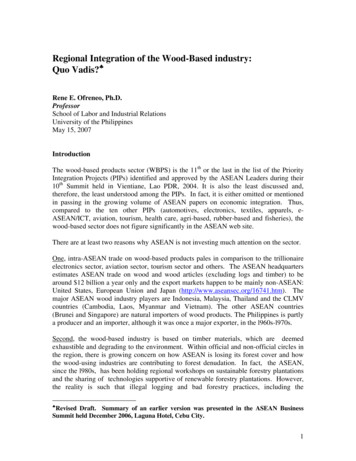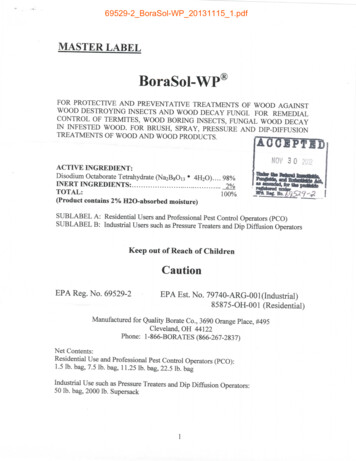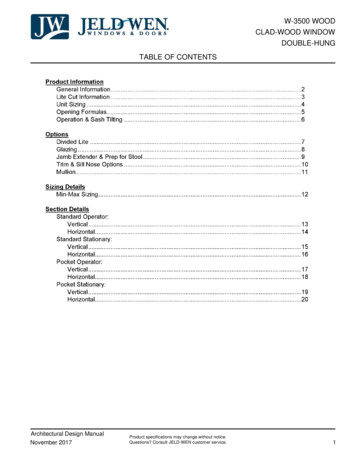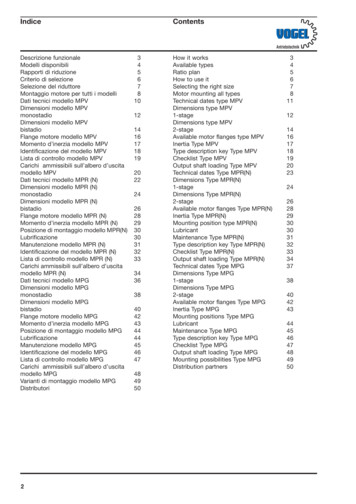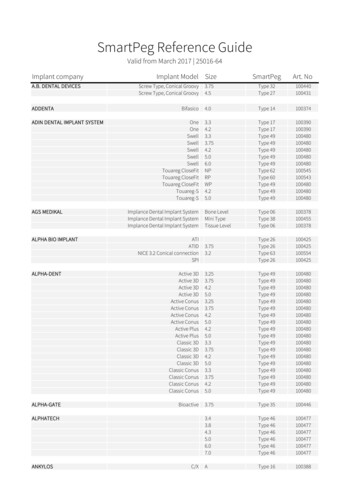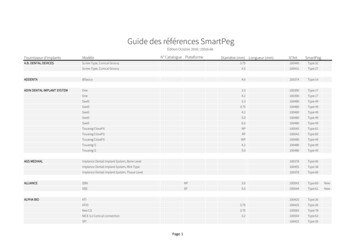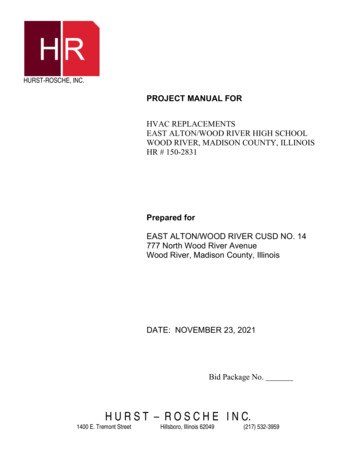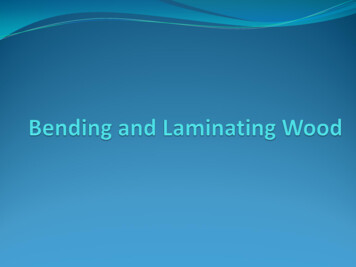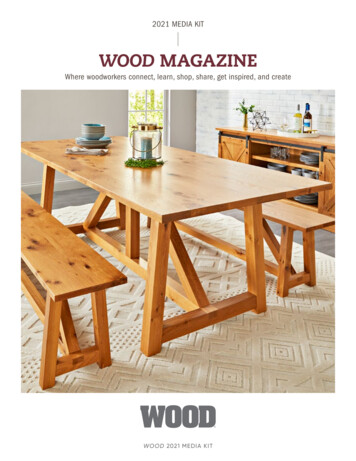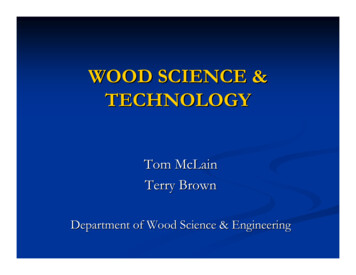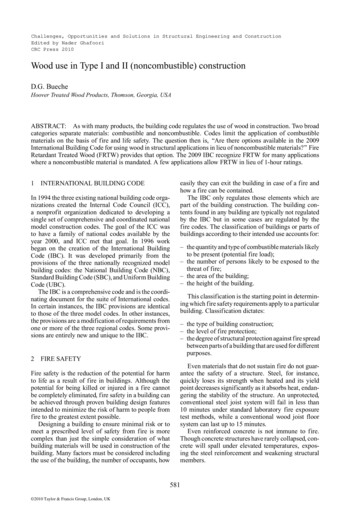
Transcription
Challenges, Opportunities and Solutions in Structural Engineering and ConstructionEdited by Nader GhafooriCRC Press 2010Wood use in Type I and II (noncombustible) constructionD.G. BuecheHoover Treated Wood Products, Thomson, Georgia, USAABSTRACT: As with many products, the building code regulates the use of wood in construction. Two broadcategories separate materials: combustible and noncombustible. Codes limit the application of combustiblematerials on the basis of fire and life safety. The question then is, ‘‘Are there options available in the 2009International Building Code for using wood in structural applications in lieu of noncombustible materials?’’ FireRetardant Treated Wood (FRTW) provides that option. The 2009 IBC recognize FRTW for many applicationswhere a noncombustible material is mandated. A few applications allow FRTW in lieu of 1-hour ratings.1INTERNATIONAL BUILDING CODEIn 1994 the three existing national building code organizations created the Internal Code Council (ICC),a nonprofit organization dedicated to developing asingle set of comprehensive and coordinated nationalmodel construction codes. The goal of the ICC wasto have a family of national codes available by theyear 2000, and ICC met that goal. In 1996 workbegan on the creation of the International BuildingCode (IBC). It was developed primarily from theprovisions of the three nationally recognized modelbuilding codes: the National Building Code (NBC),Standard Building Code (SBC), and Uniform BuildingCode (UBC).The IBC is a comprehensive code and is the coordinating document for the suite of International codes.In certain instances, the IBC provisions are identicalto those of the three model codes. In other instances,the provisions are a modification of requirements fromone or more of the three regional codes. Some provisions are entirely new and unique to the IBC.2FIRE SAFETYFire safety is the reduction of the potential for harmto life as a result of fire in buildings. Although thepotential for being killed or injured in a fire cannotbe completely eliminated, fire safety in a building canbe achieved through proven building design featuresintended to minimize the risk of harm to people fromfire to the greatest extent possible.Designing a building to ensure minimal risk or tomeet a prescribed level of safety from fire is morecomplex than just the simple consideration of whatbuilding materials will be used in construction of thebuilding. Many factors must be considered includingthe use of the building, the number of occupants, howeasily they can exit the building in case of a fire andhow a fire can be contained.The IBC only regulates those elements which arepart of the building construction. The building contents found in any building are typically not regulatedby the IBC but in some cases are regulated by thefire codes. The classification of buildings or parts ofbuildings according to their intended use accounts for:– the quantity and type of combustible materials likelyto be present (potential fire load);– the number of persons likely to be exposed to thethreat of fire;– the area of the building;– the height of the building.This classification is the starting point in determining which fire safety requirements apply to a particularbuilding. Classification dictates:– the type of building construction;– the level of fire protection;– the degree of structural protection against fire spreadbetween parts of a building that are used for differentpurposes.Even materials that do not sustain fire do not guarantee the safety of a structure. Steel, for instance,quickly loses its strength when heated and its yieldpoint decreases significantly as it absorbs heat, endangering the stability of the structure. An unprotected,conventional steel joist system will fail in less than10 minutes under standard laboratory fire exposuretest methods, while a conventional wood joist floorsystem can last up to 15 minutes.Even reinforced concrete is not immune to fire.Though concrete structures have rarely collapsed, concrete will spall under elevated temperatures, exposing the steel reinforcement and weakening structuralmembers.581 2010 Taylor & Francis Group, London, UK
It is generally recognized then, that there is really nosuch thing as a fireproof building. Fires can occur inany type of structure. The severity of a fire, however,is contingent on the ability of a construction to:– confine the fire;– limit its effects on the supporting structure;– control the spread of smoke and gases.To varying degrees, any type of construction canbe designed as a system, that is, a combination ofconstruction assemblies, to limit the effects of fire.This allows occupants sufficient time to escape thebuilding and for firefighters to safely reach the seat ofthe fire.Occupant safety also depends on other parameters such as detection and exit paths, and the use ofautomatic fire suppression systems such as sprinklers.These concepts form the basis of the IBC.3FIRE RETARDANT TREATED WOODWood loses its strength in a different way than metals. In the early stages of a fire, wood’s strength isincreased because of a reduction in moisture content.Wood is a good insulator and does not transfer the heaton its surfaces to its core very quickly. While it may beburning or charring on its surface, its interior will berelatively cool for a long time. All this increases thelength of time wood and fire retardant treated woodwill retain its integrity—time to get the people out ofthe building, time to get the firemen to the building,and time to extinguish the fire. Fire retardant treatedwood has the added advantage of maintaining structural integrity even longer because it chars at a slowerrate than untreated wood is consumed. In addition, fireretardant treated wood will not spread the fire from oneportion of a building to another, and it will extinguishitself once the ignition source is removed.Wood is principally composed of cellulose, hemicellulose, and lignin, all of which change their physical and chemical characteristics by oxidation andchemical decomposition. This phenomenon is calledcombustion or burning. It destroys the structure of thewood so it will not support a load by reducing it toa small amount (1% or less) of a mineral substancecalled ash.The kindling temperature of wood (500 F) is thetemperature above which the wood will ignite spontaneously. At this point, as a result of chemical decomposition, the wood contributes a heat of its own, andthe temperature rises even higher. Combustible gasesand smoke are given off, and the wood begins tochar. Because wood in itself is a good insulator, thehigh temperature at the surface is not readily transmitted to its interior. This insulating quality and themoisture always present in the wood results in a slowdestruction, especially of large timbers. How quicklythe material burns, depends on its size, shape, the aircirculation, and the control of radiation. Therefore, ifthe conduction of heat in the wood can be controlled toprevent the temperature of the wood from exceedingits kindling temperature, its rate of destruction canbe greatly reduced. This is the key to Fire RetardantPressure Treated Wood.Research has shown that certain ingredients, whenadded to the wood, are able to insulate its surfaces sothat its temperature remains below the kindling temperature for an extended period of time no matter howhot the heat source might become. Among the ingredients used for this purpose are the acid salts of sulfatesand phosphates, borates, and boric acid.All fire retardant treatments are water-soluble sowater is used as the vehicle for carrying the treatmentsinto the wood. The only effective method of application is by the Pressure Treatment Process. After pressure impregnation, most of the moisture is removeduntil the treated wood has a moisture content of nomore than 19% for lumber and 15% for plywood.Fire retardant treatments do not necessarily preventwood from being destroyed by fire, but they are thenecessary ingredient that, when added to wood, slowdown the decomposition to such an extent that thewood structurally out performs most other buildingmaterials during actual fire conditions.When temperatures reach a point slightly below thekindling point, the chemicals react with each other.Nonflammable gases and water vapor are formed andreleased at a slow persistent rate which envelope thewood fibers insulating them from temperatures thatcause the wood to decompose. The inflammable gasesand tars are reduced and an insulating char forms on thesurface of the wood, further slowing down the processof decomposition.Because of the greatly reduced rate of decomposition or burning, the structural integrity of the wood ispreserved for a long period of time, smoke and toxicfumes are greatly reduced, and when the heat sourceis removed, the wood ceases to decompose and thespread of fire by the wood is eliminated.In Section 2303.2, the IBC defines fire-retardanttreated wood as ‘‘any wood product which, whenimpregnated with chemicals by a pressure processor other means during manufacture, shall have, whentested in accordance with ASTM E 84, a listed flamespread index of 25 or less and show no evidence ofsignificant progressive combustion when the test iscontinued for an additional 20-minute period. In addition, the flame front shall not progress more than10.5 feet (3200 mm) beyond the centerline of theburners at any time during the test.’’This definition is a performance specification.Unlike the specifications for wood preservatives, fireretardant treated wood is specified on the basis of performance and not retention. The ‘‘Flame Spread’’ indexis a measure of the surface burning characteristics of582 2010 Taylor & Francis Group, London, UK
a building material when compared to the relativesurface burning characteristics of cement board (ratedat 0) and untreated select red oak flooring (rated at100). The index is determined by relative performance in a 25-foot long fire test tunnel furnace undercontrolled conditions of draft and temperature.In the ASTM E-84 tunnel test, a gas jet is locatednear one end of the tunnel. Without a test specimenpresent in the tunnel, the ignition flame from the gasjet extends down the tunnel for a distance of 4½ feetfrom the burners. After a test specimen is placed in thetunnel and exposed to the ignition flame for a period of10 minutes, the spread of the flame is measured fromthe fire end of the tunnel.Keep in mind that the standard flame spread test isonly for 10 minutes. The opinion of researchers wasthat this method only demonstrated delayed ignitionand gave little indication of non-combustibility. Toremedy this, the test period for fire retardant treatedwood was extended another 20 minutes to 30 minutes duration. If the specimen shows no evidence ofadditional spread of flame beyond the limit attained in10 minutes, then the specimen could be said to showno significant progressive combustion. Fire retardanttreated wood must meet this additional test standard tobe used for structural applications.4TYPES OF CONSTRUCTIONSimilar to the previous codes, construction type provisions are set out in Chapter 6 of the IBC. The type ofconstruction is determined by two factors: 1) whetherthe materials used in the structural frame are combustible or noncombustible, and 2) the fire resistanceof building elements. Noncombustible materials canhave very little fire resistance (for instance, steel framing when subjected to a hot fire can fail quickly),and so combustibility and fire resistance are separatedetermining factors in type of construction.In the IBC there are five types of construction, andthey are summarized in Table 1. Types III throughV are primarily wood frame construction; Type IIIis wood frame with noncombustible or fire-retardanttreated wood exterior walls, Type IV is heavy timber, and Type V is generally thought of as woodframe. The ‘‘A’’ designation in these constructiontypes means the building elements for the most partare required to be of one-hour rated construction. The‘‘B’’ designation means that no fire resistance ratingis required (referred to as ‘‘unprotected’’ wood frameconstruction).Even in the noncombustible construction types(Types I and II), many nonstructural elements ofthe building, such as floor coverings, windows anddoors, and interior finishes, can be wood. Permitted combustible building elements in noncombustiblebuildings are conveniently listed in Section 603 of theTable 1.TypeIBC descriptionNoncombustibleType I (A & B)Type II (A)Type II (B)Mixed noncombustible and combustibleType III (A)including frame and heavy timber (HT) Type III (B)Type IV (HT)Combustible—traditional wood frameType V (A)Type V (B)Table 2.Allowable uses of FRTW in the IBC.TypeBuilding assemblyI and IINonbearing partitions where the requiredfire-resistance rating is 2 hoursor less (Section 603.1.25.1)Nonbearing exterior walls where no fire ratingis required (Section 603.1.25.2)Roof construction including girders, trusses,framing and decking (Section 603.1.25.3)III and IVPermitted within exterior wall assemblies ofa 2-hour rating or less (Sections 602.3and 602.4)VUse of FRTW is unrestrictedIBC. This list includes structural elements that areconstructed of fire retardant treated wood (FRTW).FRTW is not considered noncombustible, but canoften be used in place of noncombustible materials.For instance, FRTW can be used in place of noncombustible materials in exterior walls of Type III and IVbuildings, and in roof structures of low-rise buildingsof Types I and II construction. Table 2 summarizeswhere fire-retardant treated wood is permitted to beused in lieu of noncombustible materials.In Section 602.3, the IBC defines Type III Construction as being ‘‘that type in which the exteriorwalls are of noncombustible materials and the interiorbuilding elements are of any material permitted by thecode.’’ The section goes on to say that fire-retardanttreated wood is permitted in exterior wall assembliesin lieu of noncombustible materials when the rating ofthe wall is required to be 2-hours or less. Therefore,for many of the most common occupancies, buildingsconstructed entirely of wood can be just as large andas high as noncombustible buildings. Table 3 showsthat buildings of IBC Type IIIB in many occupancies,may be just as large as buildings of Type IIB (noncombustible unprotected). Buildings of Type IIIB, for theoccupancies shown, may be entirely of wood if FRTWis used in the exterior walls.583 2010 Taylor & Francis Group, London, UKTypes of construction in the IBC.
Table 3. Comparison of IBC Type IIB and IIIB construction.IBC Table 503allowable area (sq ft)IBC Table 503allowable height(stories/feet)IBCOccupancyType IIBType IIIBType IIBType /553/55The IBC permits sprinklered buildings withNational Fire Protection Association NFPA 13 systems to contain one additional story and be increasedin height 20 feet. Residential buildings with NFPA13R systems may be increased one story and 20 feetin height and are not subject to the total building arealimit of a three story building (13R is only appropriateup to four stories above grade plane).In the IBC, a rated wall in accordance with Table602 can be used to separate a building into two smallerareas, neither of which exceeds threshold values thatrequire installation of sprinklers. This is not considered a fire wall separating buildings. It is a fire separation assembly, separating the building into fire areas.5FIRE RESISTANCEFire retardant treated wood has a surface burning classification and, by itself, does not have a resistancerating in hours any greater than untreated wood. Fireratings in hours are assigned to wall, floor, and roofdeck assemblies, following testing in accordance withASTM E 119. References such as the UnderwritersLaboratories ‘‘Fire Resistance Directory’’ specifically point out that FRT wood may be substitutedfor untreated wood in any related assembly. FRTWcan be used as a component of such assemblies instructures where the code does not permit the use ofuntreated wood.Descriptions of fire resistance rated assembliesincorporating structural lumber are listed in IBC Table720.1(2) as well several publications referenced by theIBC including:wall or partition assembly (WP 3605) that has wood studs covered by 5/8 Type X gypsum board withspecified nailing and positioning of the panels. Thisassembly could be used for interior, non-bearing partitions, requiring a one hour rating in a noncombustiblestructure if the studs were FRTW. In a similar manner,by substituting FRTW for untreated wood, other oneand two hour wall and ceiling assemblies can be usedin noncombustible type buildings. The IBC also permit use of ceiling assemblies with the top membraneomitted where only unused attic space is above.The IBC permits asymmetric testing for fire resistance rating (testing from the inside only) where thedistance to the property line is at least 5 feet.If sprinklering is not used for H&A increases, itis permitted to reduce fire resistive requirements byone hour for all construction elements except exteriorwalls.6CASE STUDIESFigure 1 shows a 1.2 million square foot warehousethat was developed for multiple tenants and featuresa hybrid panelized roof system utilizing fire retardant treated wood. The hybrid roof system consists of4 ft 8 ft fire retardant treated plywood on 2x and 3xfire retardant treated sawn lumber subpurlins. The primary framing consists of steel bar joist spaced 8 ft oncenter with steel girder trusses as the main structuralmembers. This system uses panelized units assembledon the ground and then lifted into position at the rooflevel, where the steel bar joists are welded or bolted tothe primary steel girder trusses. The free edge of thewood decking for each panelized unit is nailed to theframing edge of the previously placed unit. Pre-framedpanel ends attached to the main steel trusses completethe assembly.In a fire retardant treated wood roof system, thepanelized wood sections speed the erection process– Fire Resistance Directory, published by Underwriters Laboratories;– Fire Resistance Design Manual, published by theGypsum Association.As way of example, the Gypsum Association’s‘‘Fire Resistance Design Manual’’ contains a one hourFigure 1.584 2010 Taylor & Francis Group, London, UKFRTW panelized roof system.
Figure 2.Apartment complex utilizing FRTW studs.Figure 3.The Orchard shopping mall.and add strength, dimensional stability, and highdiaphragm capacity to the roof. The ability to preframe large roof panelized units reduce cost, cutsconstruction time, and enhances job site safety sincefewer man-hours are spent on the roof. Panelized roofsystems are one of the safest systems to erect becausemost of the work is accomplished on the groundduring the fabrication of the large pre-framed roofpanels. Once the large panels are lifted into positionat the proper roof elevation, only one or two workersare required on the roof to complete the final purlinattachments and diaphragm nailing.Another advantage to the hybrid panelized roof system is the speed at which it can be constructed. In thiscase, the entire 1,200,000 square-foot roof was erectedin only 5 weeks with minimal overtime required. Anexperienced 4 man crew can erect 25,000 square feetof roof per day.The apartment complex in Figure 2 contains 500,000square feet of residential space, 40,000 square feet ofretail space, and a 350,000 square foot parking garage.The exterior bearing walls are constructed with fireretardant treated wood studs. The interior framing isuntreated wood.The two story parking garage consists of a onestory enclosed parking garage and a one-story opengarage. The parking garages are not considered indetermining the maximum number of stories allowedin the building under the IBC when constructed ofType I construction and a three hour occupancy separation is maintained between the parking garage andthe residential occupancy.The IBC allows the base area to be doubled and aone-story height increase when a NFPA 13 sprinklersystem is installed.Figure 3 is The Orchard at Westminster, designedto be reminiscent of the Main Streets of small townsin the first half of the 20th century. It is an openair, entertainment and lifestyle center that comprisesa million square feet of exclusive, outdoor, fashionoriented retail including big boxes, department storesand smaller, upscale retailers. The development alsoincludes 500 housing units and office space. The namewas selected to reflect the rich agricultural heritage ofthe area, which was home to some of the largest appleorchards in Colorado.It was designed under the IBC to be a Type II noncombustible structure of concrete and steel. The IBCallows fire retardant treated to be used in the roofsand nonbearing walls of noncombustible types of construction. Fire retardant treated plywood was used asroof sheathing over light gauge steel roof trusses providing an easy to nail surface for the 3-dimensionalarchitectural composite shingles.REFERENCE2009 International Building Code. International Code Council, Inc. Country Club Hills, IL.585 2010 Taylor & Francis Group, London, UK
determining factors in type of construction. In the IBC there are five types of construction, and they are summarized in Table 1. Types III through V are primarily wood frame construction; Type III is wood frame with noncombustible or fire-retardant treated wood exterior walls, Type IV is heavy tim-ber, and Type V is generally thought of as .
